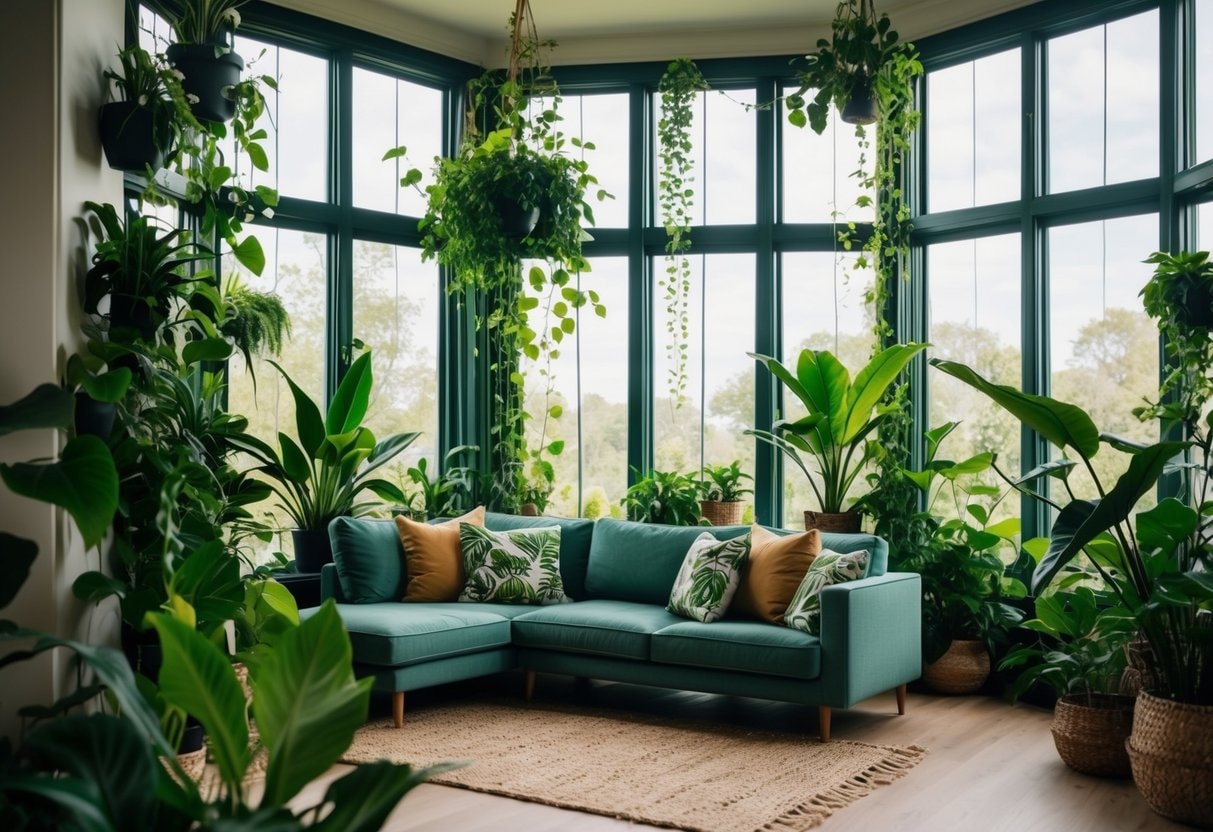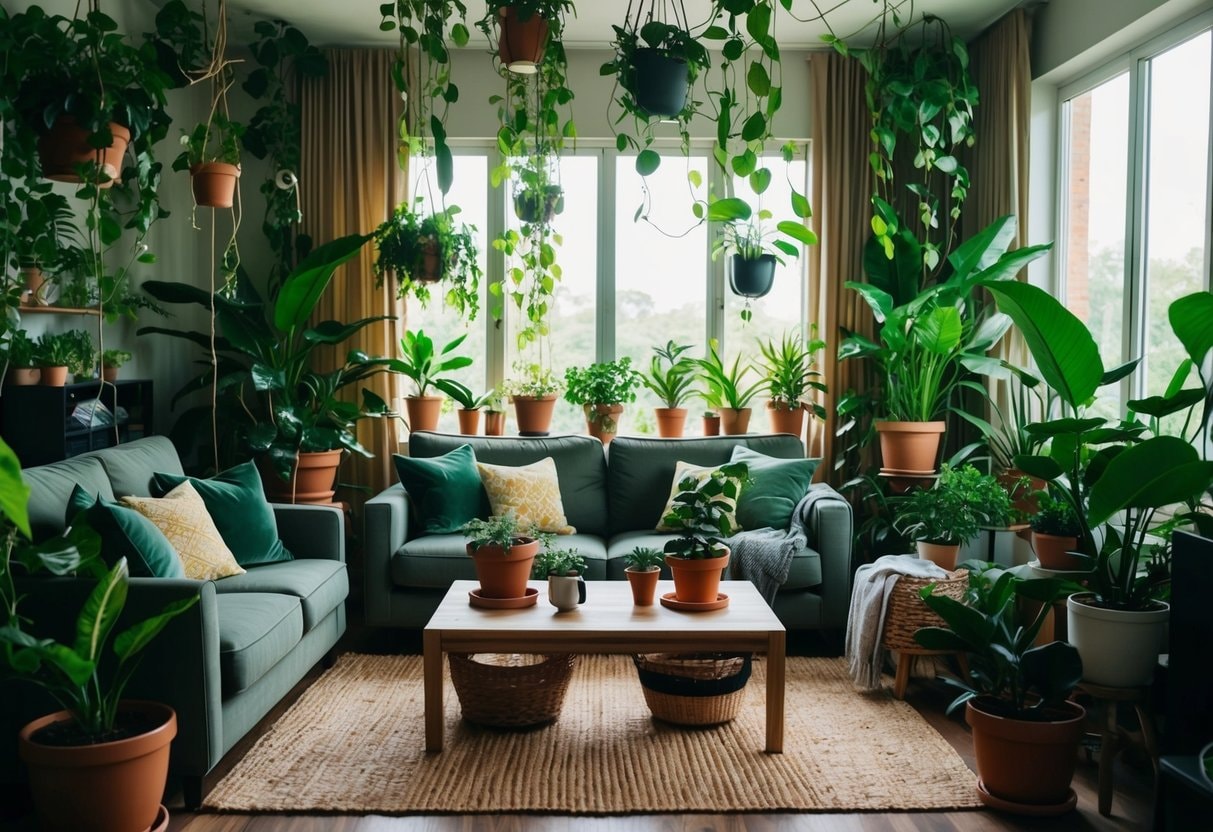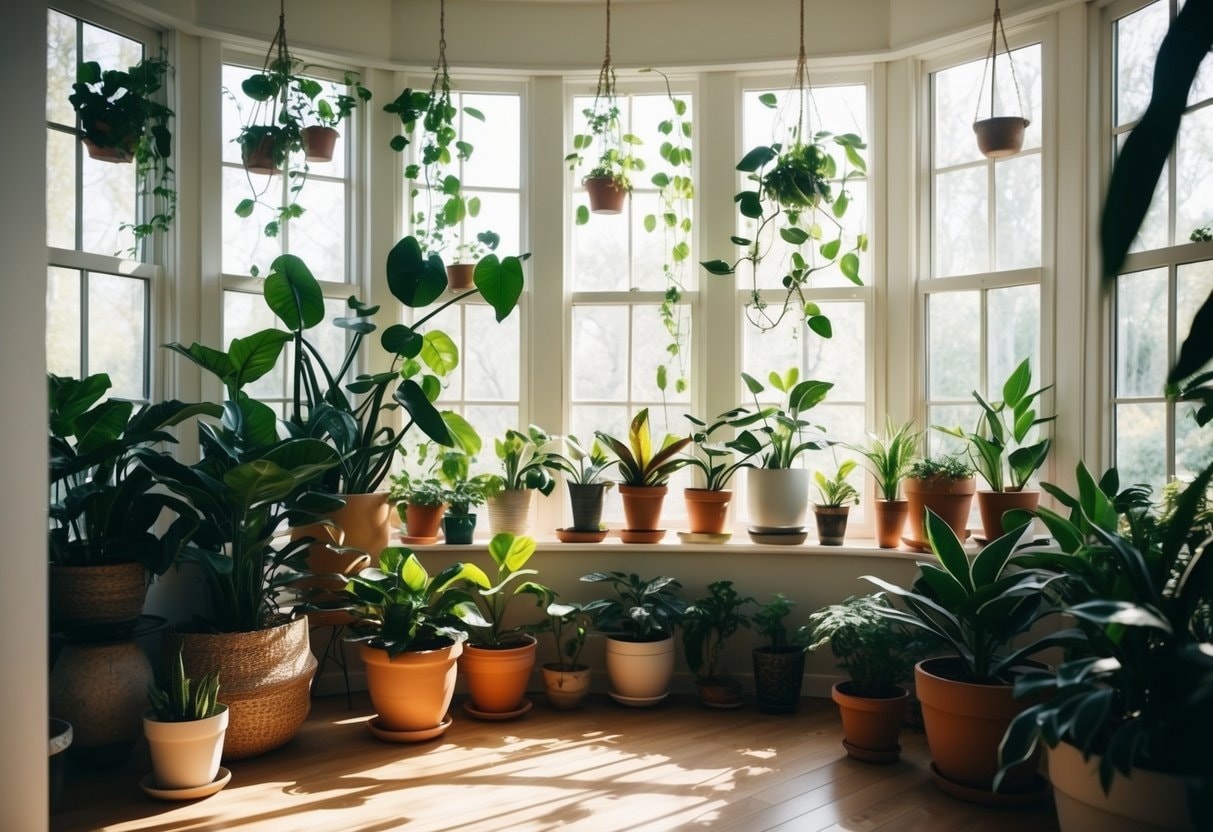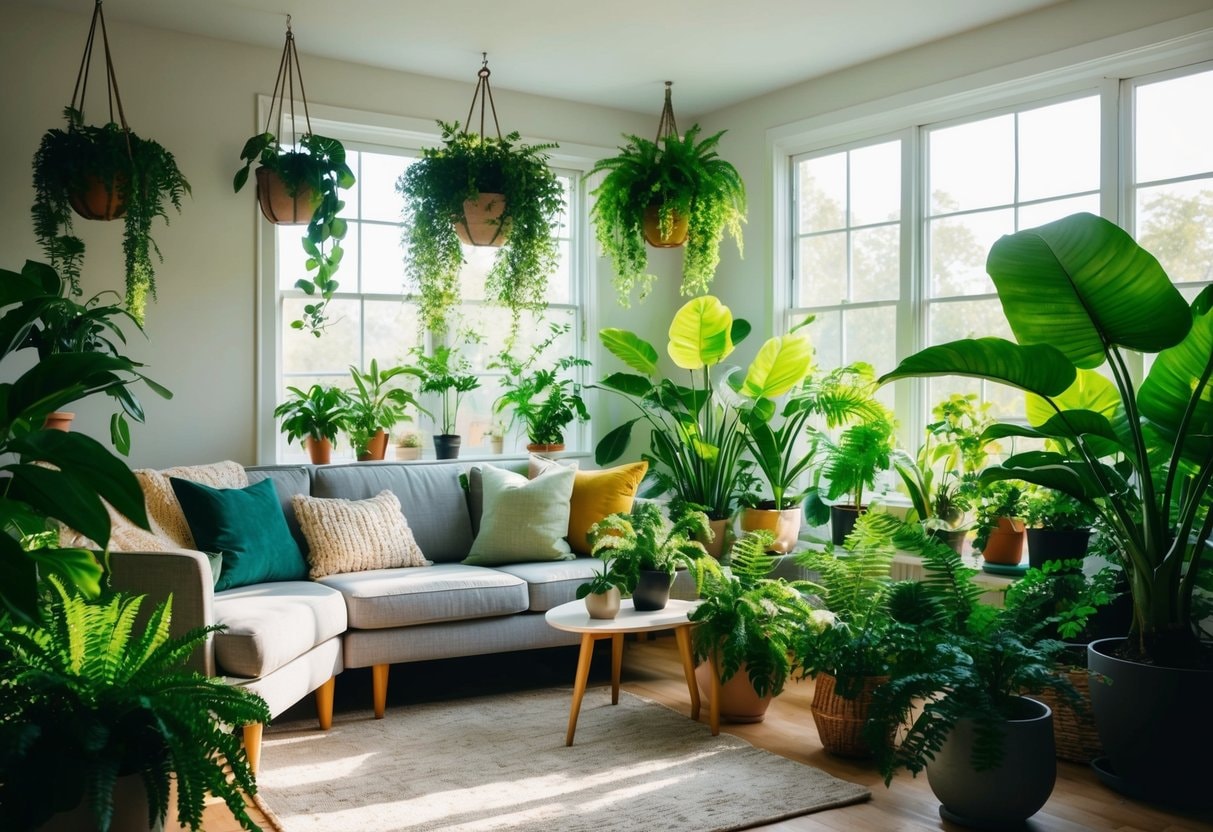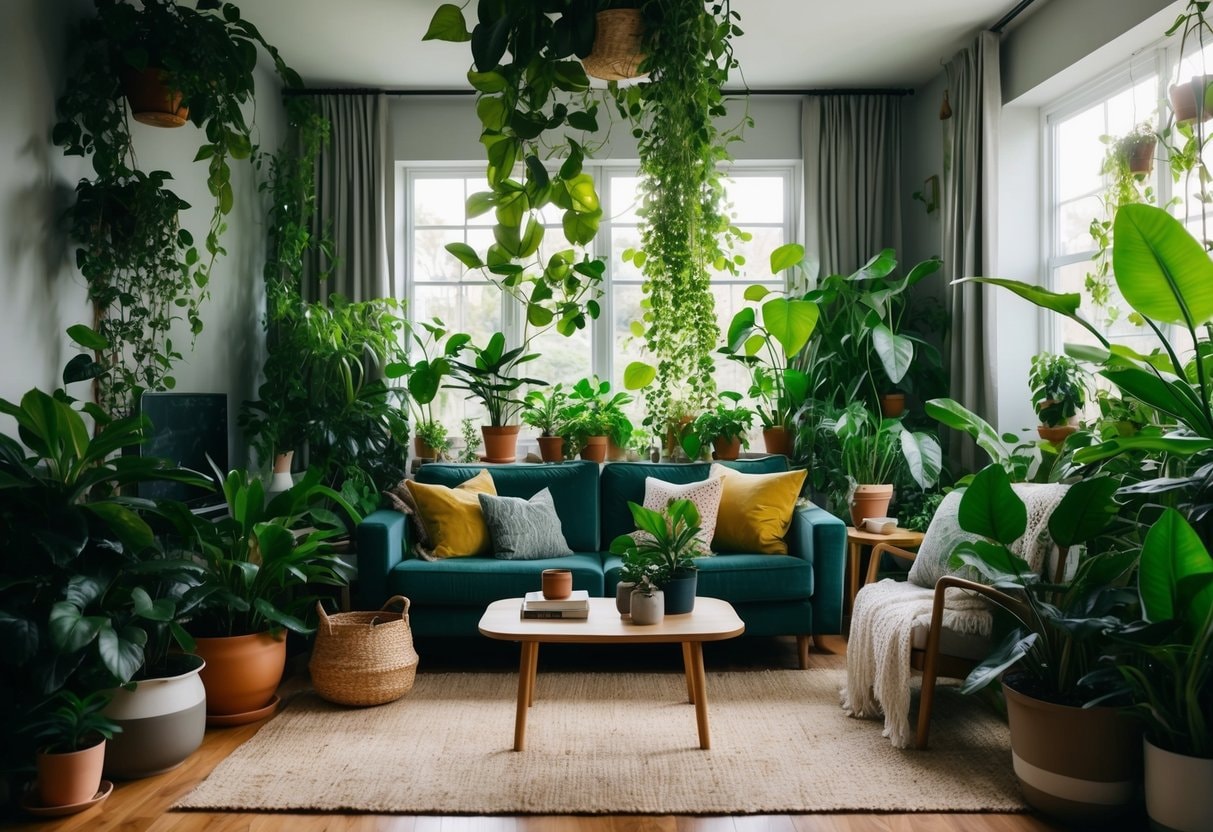HousePlantJoy is supported by our audience. When you purchase through one of our links, we may earn a small affiliate commission. As an Amazon Associate I earn from qualifying purchases. Your cost is not affected.
==================
Imagine stepping into your home sweet jungle and instantly feeling a wave of calm wash over you, as if you’ve entered a serene green oasis. The air is fresher, the atmosphere more peaceful, and the vibrant hues of foliage surround you, creating a sanctuary from the outside world. This dream can become a reality with the right approach to transforming your living space into a lush indoor jungle. Not only does this green retreat enhance your home’s aesthetics, but it also promotes well-being by reducing stress and improving air quality.
Creating your indoor jungle doesn’t require a master gardener’s skills or an extensive knowledge of botany. With simple tips, anyone can cultivate a thriving ecosystem within their walls. From selecting the perfect plants to arranging them for maximum impact, this journey toward a greener home is easier than you might think. Ready to dive in? Let’s explore how you can turn your space into a tranquil haven that nourishes your mind and spirit.
Transform Your Space: Create Your Own Indoor Jungle for a Healthier, Happier Home
Bringing nature indoors can change your life. Imagine walking into your home sweet jungle and feeling like you’ve stepped into a lush, green oasis. This is what an indoor jungle can do for you. Creating a jungle-like atmosphere in your home can reduce stress, clean the air, and boost your mood.
You don’t need a green thumb to start. With some simple tips and tricks, you can turn any room into a thriving ecosystem. From picking the right plants to designing your space, it’s easier than you think to bring the outdoors in.
Ready to transform your living space? Let’s explore how to create your own indoor jungle. You’ll learn about the best plants for your home, how to care for them, and ways to make your space feel like a calming retreat.
Key Takeaways
- Indoor jungles improve air quality and reduce stress, promoting a healthier and happier living environment.
- Choose plants that thrive in your home’s light conditions and match your maintenance preferences for a thriving indoor ecosystem.
- Create a serene atmosphere by arranging plants at various heights and incorporating natural elements like wood and stone.
- Regular watering, proper lighting, and occasional pruning are essential for maintaining your indoor jungle’s health and beauty.
Benefits of Living Amidst Greenery
Living with plants can make you happier and healthier. Indoor jungles help clean the air and reduce stress. You’ll breathe easier and feel more relaxed in a green space. Plants can lift your mood and increase your focus.
Working or relaxing among greenery might make you more productive and creative. Indoor jungles also make your home look amazing. They add color, texture, and life to any room. Your space will feel more inviting and cozy with plants around.
Understanding the Jungle Aesthetic
The jungle look is all about lush, layered greenery. You want to mix different plant types, sizes, and textures. Think big leafy plants, hanging vines, and small potted beauties. Urban jungle style often uses earthy colors. Greens, browns, and warm neutrals create a calm, natural feel. Add pops of color with bright flowers or colorful pots.
Don’t forget about placement. Group plants at different heights. Use shelves, hanging baskets, and floor stands to create depth. Let some plants trail down walls or bookcases for that wild jungle vibe.
Designing Your Indoor Jungle
Creating your own indoor jungle, or what some might call a home sweet jungle, lets you bring nature’s beauty inside. It can make your home feel more peaceful and alive. Here’s how to get started:
Selecting the Right Plants
Choose plants that match your home’s light levels. For bright spaces, try Aloe Vera or Areca Palm. If you have less light, go for snake plants or pothos. Pick a mix of sizes. Large plants like fiddle leaf figs make a statement. Small succulents add detail.
Think about care needs. If you’re busy, pick low-maintenance plants like ZZ plants or rubber trees. Add variety with different leaf shapes and colors. Mix broad leaves with spiky ones. Include some plants with colorful foliage for visual interest.
Layout Considerations for Your Space
Start with a focal point. A big, eye-catching plant can anchor your design. Use hanging plants to add layers. They draw the eye up and make your space feel fuller. Group plants of different heights. This creates a natural, forest-like feel.
Use plant stands or shelves to add levels. This helps you fit more plants in a small space. Don’t forget about corners. Tall plants can soften these often-unused areas. Leave some breathing room. Too many plants can make a space feel cluttered.
Incorporating Natural Elements
Add natural textures with baskets, wood, or stone planters. These complement your plants nicely. Use pebbles or moss as topsoil cover. It looks nice and helps keep moisture in. Try a small indoor fountain. The sound of water adds to the jungle feel.
Hang nature-inspired art. Botanical prints or landscape photos can enhance the theme. Use natural fabrics like cotton or linen for curtains and pillows. They blend well with plants. Bring in some natural light with sheer curtains. Plants love it, and it adds to the outdoor feel.
Did You Know?
Thinking vertically is key to arranging plants in a small living area to create a calming ecosystem. Wall-mounted planters or hanging baskets can add greenery without occupying floor space. Taller plants can be placed in corners, while smaller ones can sit on shelves or tables. Grouping plants of different heights together will add depth, making the space feel lush and jungle-like, even in limited areas.
Optimal Lighting for Growth
Light is food for plants. Most indoor plants need bright, indirect light. Place them near windows that face east or west. South-facing windows work, too, but use sheer curtains to filter strong sunlight.
Some plants can handle low light. Snake plants and ZZ plants are great for dark corners. If you have a dim room, try to grow lights. They come in many shapes and sizes to fit your space. Watch your plants for signs they need more light. Pale leaves or slow growth mean they’re not getting enough sun.
Watering Techniques and Schedules
Water is tricky. Too much can rot roots, and too little can dry plants out. Most plants like soil that’s moist but not soggy. Check the soil before watering. Stick your finger an inch deep. If it’s dry, it’s time to water. Use room-temperature water and pour slowly until it drains out the bottom.
Water less in winter when plants grow slower. Mist leaves of tropical plants to boost humidity. A pebble tray with water under the pot also helps. Set reminders on your phone to water. Each plant is different, so learn their needs.
Soil and Nutrient Essentials
Good soil is the base for healthy plants. Use a potting mix made for indoor plants. It should drain well but hold some water. Add perlite or sand to heavy soil to improve drainage. This stops water from sitting around roots. Feed your plants during growing seasons.
Use a balanced liquid fertilizer every few weeks. Follow the label for how much to use. Some plants, like ferns, like acidic soil. You can buy special mixes for these picky plants. Repot plants when roots peek out of drainage holes. Spring is the best time to do this.
Color Palettes and Textures
Pick calming colors for your indoor jungle. Soft greens, blues, and earthy tones work well. These shades help you feel relaxed and connected to nature. Add texture with different leaf shapes and sizes.
Mix smooth, glossy leaves with fuzzy or spiky ones. This creates visual interest without being too busy. Try grouping plants in odd numbers. Place three or five plants together for a pleasing look. Use plants of different heights to create depth and draw the eye upward.
Fragrances and Air Purifying Plants
Choose plants that smell nice and clean the air. Lavender and jasmine are known for their soothing scents. They can help you relax after a long day. Some great air-cleaning plants include:
- Spider plants
- Peace lilies
- Snake plants
These oxygenating plants remove toxins from the air. They make your space healthier to breathe in. Place scented plants near seating areas. This way, you can enjoy their fragrances while you relax.
The Sound of Nature: Integrating Water Features
Add a small fountain or water feature to your indoor jungle. The gentle sound of flowing water can mask outside noise and help you feel calm. Choose a tabletop fountain for small spaces. For larger areas, try a wall-mounted water feature.
Make sure it’s easy to clean and refill. Place water-loving plants near your fountain. Ferns and peace lilies thrive in humid spots. This creates a lush, tropical feel in your home.
Sustainable Gardening Indoors
Choose pots made from recycled or biodegradable materials. Coconut coir, bamboo, and recycled plastic are great options. Use organic potting soil and natural fertilizers like compost tea or worm castings.
Opt for plants that clean the air. Spider plants, peace lilies, and snake plants are excellent air purifiers. They remove toxins and improve indoor air quality naturally. Propagate your own plants.
Take cuttings from existing plants to grow new ones. This saves money and reduces plastic waste from buying new plants. Try vertical gardening. Use wall-mounted planters or hanging baskets to maximize space. This method is perfect for small apartments and adds a unique touch to your decor.
Conserving Water with Smart Choices
Install a rainwater collection system on your balcony or windowsill. Use this water for your plants instead of tap water. It’s free and eco-friendly. Group plants with similar water needs together. This prevents overwatering and saves water. Succulents and cacti need less water than tropical plants.
Use mulch in your pots. A layer of pebbles or bark on top of the soil reduces water evaporation. Your plants will need less frequent watering. Try self-watering pots. These have a reservoir that stores water and releases it slowly. They’re great for busy plant parents and help prevent overwatering.
Planters and Pots with Personality
Urban Jungle interior design isn’t complete without eye-catching planters. Look for pots with unique shapes, textures, or patterns to add visual interest. Hanging planters can save floor space and create a cascading effect.
Try self-watering pots to make plant care less demanding. These clever containers have a water reservoir that slowly releases moisture to your plants. For a DIY touch, paint terracotta pots with fun designs or use washi tape to create geometric patterns.
You can also repurpose everyday items like teacups or old boots as quirky planters. Don’t forget about plant stands! These can elevate your greenery and create different height levels in your indoor jungle.
Technology for Plant Enthusiasts
Smart gadgets can help you create a stylish indoor jungle with less effort. Automatic watering systems take the guesswork out of plant care. You can set schedules and water amounts for each plant.
Plant sensors are another handy tool. They track soil moisture, light levels, and temperature. This data helps you provide the best care for your green friends. LED grow lights can supplement natural light in darker corners of your home.
These come in various styles, from clip-on spots to elegant floor lamps. Tech-savvy gardeners should try apps that identify plants and provide care tips. Some even let you track your plants’ growth and set care reminders.
Regular Pruning and Care
Pruning is key to keeping your indoor plants healthy. Remove any dead or yellowing leaves to encourage new growth. This also helps your plants look their best. Water your plants as needed. Each plant has different needs.
Some like to dry out between waterings, while others prefer constant moisture. Check the soil with your finger before watering. Dust the leaves gently with a soft, damp cloth. This helps your plants breathe better and keeps them looking fresh.
It’s also a great time to check for any issues. Rotate your plants every few weeks. This ensures all sides get equal light exposure. It prevents lopsided growth and keeps your plants balanced and beautiful.
Pest Control and Prevention
Pests can be a big problem for indoor jungles. Keep an eye out for common bugs like spider mites, mealybugs, and fungus gnats. Check both the tops and bottoms of leaves regularly. If you spot pests, act fast. Isolate the affected plant to prevent spread. You can often remove small infestations by hand or with a cotton swab dipped in rubbing alcohol.
For bigger problems, try neem oil or insecticidal soap. These are safe options for indoor use and won’t harm your plants. Prevention is best. Keep your plants healthy with proper care. Stressed plants are more likely to get pests. Also, quarantine new plants for a week or two before adding them to your jungle.
Propagating Your Plants
You can make new plants from the ones you already have. It’s easy and free! Take cuttings from healthy stems and put them in water. In a few weeks, you’ll see roots growing. Some plants grow babies called “pups” at their base.
Gently separate these and plant them in new pots. Spider plants and aloe are great for this. Leaf cuttings work well for succulents. Just lay a leaf on the soil and watch it sprout. It’s like magic! Remember to be patient. New plants need time to grow strong roots before you move them to bigger pots.
Discovering Rare and Exotic Varieties
Look beyond common houseplants to find unique additions. Plant swaps and local nurseries often have interesting choices. Online plant shops offer hard-to-find species. But be careful when buying.
Make sure the seller is trustworthy and ships plants safely. Try air plants for something different. They don’t need soil and look great in small spaces. Mounted on driftwood or in glass globes, they’re real eye-catchers.
Carnivorous plants like Venus flytraps are fun and unusual. They need special care but are worth the effort for their unique looks. Remember to research new plants before buying. Some may need extra care or special conditions to thrive in your home.
Joining Local and Online Gardening Groups
Look for plant clubs in your area. Many cities have groups that meet regularly to swap cuttings and share tips. You can often find these through community centers or local nurseries. Social media is another great way to connect. Facebook has many active plant groups.
Instagram is full of plant lovers sharing photos and advice. Join in and start chatting with others who share your passion. Online forums like Reddit’s r/houseplants are goldmines of information. You can ask questions, show off your plants, and learn from others’ experiences.
Attending Workshops and Events
Check out plant workshops at your local garden center. These often cover topics like repotting, pest control, and plant care basics. Plant swaps are fun events where you can trade cuttings or whole plants. It’s a budget-friendly way to grow your collection and meet other plant parents.
Botanical gardens often host lectures and classes. These can teach you about specific plant types or gardening techniques. Consider joining a community garden if you want to expand beyond indoor plants. It’s a great way to learn outdoor gardening skills and meet like-minded people.
Transform Your Space with a Calming Indoor Jungle Oasis
Creating a home sweet jungle brings nature’s calming essence into your home. By adding lush plants, you can transform your space into a serene oasis. Your urban jungle will not only look beautiful but also improve air quality. Plants naturally filter pollutants, making your home healthier to live in. Remember to choose plants that match your lifestyle and care abilities. Some need more attention, while others thrive on neglect. Incorporating natural elements like wood and stone can enhance the jungle feel. These materials complement the greenery and create a harmonious environment.
Don’t be afraid to mix things up. Try plants with different leaf shapes, sizes, and colors. This variety adds visual interest and depth to your indoor ecosystem. Your urban jungle can be more than just decorative. Many plants have air-purifying qualities, while some can even be used in cooking. As you nurture your indoor jungle, you’ll find it nurtures you back. The act of caring for plants can be deeply relaxing and rewarding. So go ahead, embrace the green life. Your home will thank you, and so will your well-being. Welcome to your new, lush, and calming indoor ecosystem!
What Are Some Low-maintenance Plants That Can Add a Tropical Feel to My Indoor Space?
How Can I Ensure Proper Humidity Levels for My Indoor Jungle?
What Lighting Conditions Are Best for Sustaining an Indoor Jungle Atmosphere at Home?
Which Indoor Plants Are Known to Have Air-purifying Qualities?
How Often Should I Water My Indoor Plants to Maintain a Healthy Home Jungle?
Reasons to Join Our Community!
Access Exclusive Knowledge: Discover essential tips that will help your plants thrive and flourish like never before.
Expert Support: Engage with our experienced team on social media platforms such as Facebook and Twitter. Our gardening specialists are excited to assist you on your plant journey.
Connect with Fellow Enthusiasts: Meet other plant lovers, share your experiences, and foster a supportive community. Sign up now! Follow Houseplant Joy on Facebook, Instagram, and Twitter for daily inspiration and to elevate your plant experience! #HouseplantJoy #GreenThumbsUnite #HouseplantLove


